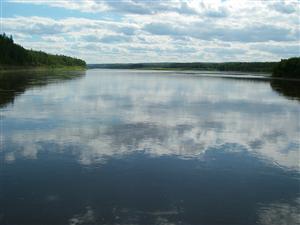Aquatic Habitats in the Lower Athabasca Region: Rivers and Streams
Rivers and streams differ from other aquatic habitats in their physical characteristics (i.e., shape, substrate) and hydrology, which is dominated by flowing water and often varies seasonally. As in lakes or wetlands, habitats and biological communities in rivers vary with depth or distance from shore and in response to seasonal changes in the environment. Significant shifts in habitats and biological communities also occur over the length of rivers due to the changing influence of riparian vegetation on shading and organic matter inputs as the river width increases (Wetzel 2001).
The distribution of fish and other aquatic organisms in rivers and streams depends on the environmental conditions they prefer or require. Oxygen levels in streams are usually sufficient for fish, and temperatures are generally similar at the surface and the bottom. Stream substrate, current strength, water depth, aquatic vegetation, and other habitat features (e.g., undercut banks, pools, woody debris), however, can vary over relatively small distances within a watercourse, providing a range of habitat for different species (Nelson and Paetz 1992).
The Athabasca River basin includes approximately 5,830 km of streams. An estimated 40% of these streams are classified as coldwater fish habitat, while the remainder is classified as coolwater fish habitat, supporting fish species such as pike, walleye, goldeye, and lake whitefish (Nelson and Paetz 1992).
See Hydrology of the Athabasca Oil Sands Region for more information on key rivers and streams in the lower Athabsca River basin.









